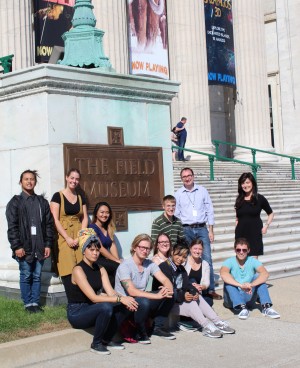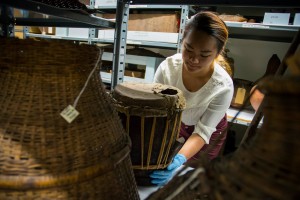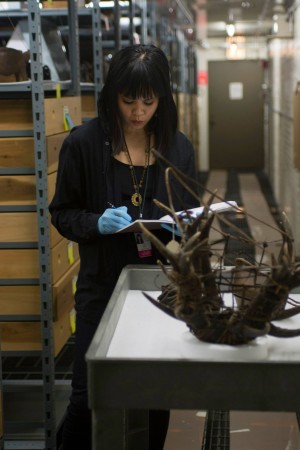Fil-Am volunteers helping digitize Field Museum’s PH artifacts
CHICAGO–Thanks to a timely grant and a troop of volunteers, the Field Museum of Natural History, one of the largest of its kind, chose its 10,000-artifact Philippine heritage collection as the pilot project for documenting its wide Anthropology collection.
The Philippine Digital Co-Curation Project is being funded by a grant from an anonymous for two years, which would allow 80 percent of the collection to be digitized and uploaded onto a web portal that would be accessible worldwide.
The collection is stored away in the museum’s vault and is accessible only to a selected few. Called co-curators, volunteers will share their expertise from 7 to 21 hours weekly. The co-curators, eight of whom are Filipino American, are made up of working professionals and students.
Cassie Pontone, the Museum assistant collections manager and supervisor of the project said, “The Field Museum has only just begun the efforts of co-curating ethnographic collections, in this fashion, last year. We have only worked with the Filipino American community in Chicago on the Philippine Heritage Collections.”
Pontone said further, “We hope this project will prove successful and help to draft a sort of template for similar work and processes that we may apply to other ethnographic collections in the museum,” she added.
The more than 10,000 artifacts were collected during a field expedition in 1907-10 by anthropologist Fay-Cooper Cole, a professor of anthropology at the University of Chicago.
Involving community
In 2010, Dr. John Terrell, the museum’s Regenstein Curator of Pacific Anthropology, introduced the idea of co-curation, a philosophy that directly involves the community from which the object of culture originated. This allowed the Fil-Am community to share responsibility for the care, use, interpretation and financial support of its heritage collection.
In the past two years, a partnership with the Field Museum and the Filipino American community established four “Kwentuhan” or storytelling sessions, which has slowly introduced the artifacts to the community.
The three earlier Kwentuhan sessions focused on artifacts from the Northern Philippines such as Ilocos, Cagayan Valley and the Cordilleras; the Mindanao areas of Cagayan de oro, Davao, Cotabato, Sulu, Surigao and Zamboanga; and Mindoro, Palawan, Southern Luzon and the Visayas.
“Feed my Soul”
“Everything about this project feeds my soul,” said Fil-Am volunteer co-curator Rose Tibayan, an award-winning journalist and publisher of The Blackline Review, a multimedia news source.
“My work at the museum consists mostly of research about the source of the artifacts. I read books and field notes to glean how the anthropologist came to collect the item, then write summary reports,” Tibayan explained.
For further insight, she read a book titled Savage Gentlemen by anthropologist Mabel Cook Cole, the wife of Fay Cooper Cole, the lead anthropologist of the Philippine expedition.
During the early years of the U.S. occupation of the Philippines, the couple, along with primary scientists William Jones and Stephen Chapman Simms, collected artifacts from the Philippines in 1907-10. Chicago Industrialist Robert Fowler Cummings funded the expedition after viewing an exhibition of Filipino tribes at the 1904 World’s Fair in St. Louis, Missouri.
Tibayan, who started volunteering two months ago, has spent 37 hours working with the digital co-curation team editing the monthly newsletters. Her interest in anthropology began in college.
During her freshman year at the University of Delaware, she majored in anthropology but later changed her major to journalism.
“Paleoanthropology has always been a great interest of mine since I studied primitive human ancestors during my freshman year in college,” she said,” However, what we do at the Field falls under ethnography — the study of people and cultures.”
“During my first day at the Field, I helped to bring a batch of sharpened bamboo sticks from the vaults to our lab which we were going to display at the Kwentuhan session which had the theme of protection,” related Tibayan.
She cited an example in Cole’s book where she had observed that warriors would spend the night in an open field and plant the bamboo sticks in the cogon grass.
“The spikes were like field mines– unseen in the grass. The enemy would step on them and injure their feet, slowing them down,” she explained.
“Upon reading this, those little bamboo spikes brought a touch of reality to the collection. These were real items used by real people in order to survive the harsh conditions in which they lived—these were not trinkets or decorations!”
“Need to Keep Alive”
Alpha Sadcopen joined the co-curation team nine months ago. She is studying graphic arts at the College of DuPage, 25 miles west of Chicago, but is considering studying anthropology.
As a member of the social organization BIBBAK (Benguet, Ifugao, Bontoc, Apayo, and Kalinga,) she and her father were invited to one of the Kwentuhan sessions.
“My father steered the BIBBAK social organization into a direction that focused more on its culture. Through my dad, I was reconnected to my culture.
“The artifacts have been sitting there for awhile with drawers and drawers of cards that have the catalog number, description, origin, dimensions, which expedition it came from, and its materials.
“So what we’re trying to do is put it on our database, Emus, so it is easier for us to look for an artifact. Let’s say someone from the community wants to do some research on a certain artifact, they can go online and see it.
“Some of these artifacts have pictures but a lot of them are not of good quality so we are working on taking nice, high quality pictures and put them on the website so that other people around the world can see it.
“I have never seen such a concentrated collection of Igorot items before, even when I was living in the Philippines. Being around them makes me feel like I’m traveling back in time and meeting ancestors that are now long gone,” she said.
Sadcopen says that some of her friends grew up ignorant of their Filipino heritage.
“I’ve met a lot of Filipinos who were born here, never went to the Philippines, and don’t know how to speak Tagalog because their parents never taught them. I can sense their frustration. They lament, ‘ How can I feel Filipino if I don’t know anything about the Philippines.’
“It would be so awesome if we could get this web site off the ground and people can learn about their culture.”
“Own my roots”
Mikayla Delson, a college photography student and intern at the Museum of Contemporary Art, spends seven hours a week working with the artifacts. One of her duties is to photograph the artifacts.
“Being able to work at the Field Museum has taught me to understand the importance of preservation and presentation. I get to take pictures, learn about my culture and I get to be behind the scenes,” she said.
Loribelle Lorenzo, a native of Dipolog, volunteers during the week on her day off from her nursing job at Loyola Hospital in Maywood, Illinois.
The most interesting artifact she has come across are “the Bolos from the South because of their intricate designs.”
Across all borders
Trisha Martin, a teaching artist at the Columbia College Chicago, has been volunteering since February. She jumped at the opportunity to co-curate when she learned about it through 10,000 Kwentos. She says she uses her lunch breaks to sketch objects.
Martin was one of 10 artists chosen to work on the project Art & Anthropology: Portraits of an Artist as a Filipino, which was also funded by the MacArthur Grant. She will work collaboratively with the other artists to develop two 7 x 28 foot mural paintings showcasing the Philippine artifacts on Nov. 3.
“Lending a hand to such a progressive project that will be a virtual educational tool while encouraging dialogue between generations, across all borders is an exciting way to own my roots,” Martin said.

The Field Museum’s Philippine Digital Co-Curation Team updates its 10,000- artifact heritage collection with a grant & help of Fil-Am volunteers. PINOY PHOTO/GRACE GARCIA
Plant specimens are also among the artifacts in the collection. Field Museum botanist, Dr. Djaja D. Soejarto, professor of pharmacognosy, at the University of Illinois in Chicago, has identified some of the collected plant specimens that were used by indigenous people.
One of the specimens he pointed out was a tiny one-inch leaf, which had been collected in Banaue on the island of Luzon. Instructions on its label read, “Hu-mang. Break in bits and put in water for dring [sic].”
Dr. Soejarto identified this plant as likely to be Lygodium japonicum (Lygodiaceae) commonly known as a Japanese climbing fern, which thrives throughout Asia.
“So far, the team has scanned approximately 6,500 original catalog cards, photographed roughly 4,000 objects and transcribed around 4,000 of those scanned cards,” Pontone said.
Donated by U.S. soldiers
One quarter of the collection was donated by American soldiers who served in the Philippine-American War during the early 1900s.
Many of the archaeological collections from the Philippines are actually Chinese in origin, ethnographically significant for their use within the Philippine culture, Pontone said.
“The Philippines anthropology collection is the best documentation that I have encountered. The anthropologists collecting these artifacts in the early 20th century were diligent workers, recording much more ethnograph data than typically reported during that time,” Pontone said.
During a Kwentuhan on August 9, the co-curation team showcased 30 items from the collection “From Blades to Spirits.” Guest speakers explained various forms of protection such as weaponry, martial arts, medicinal plants, clothing and practices to aid with good luck and ward off negativity.
Like us on Facebook
















